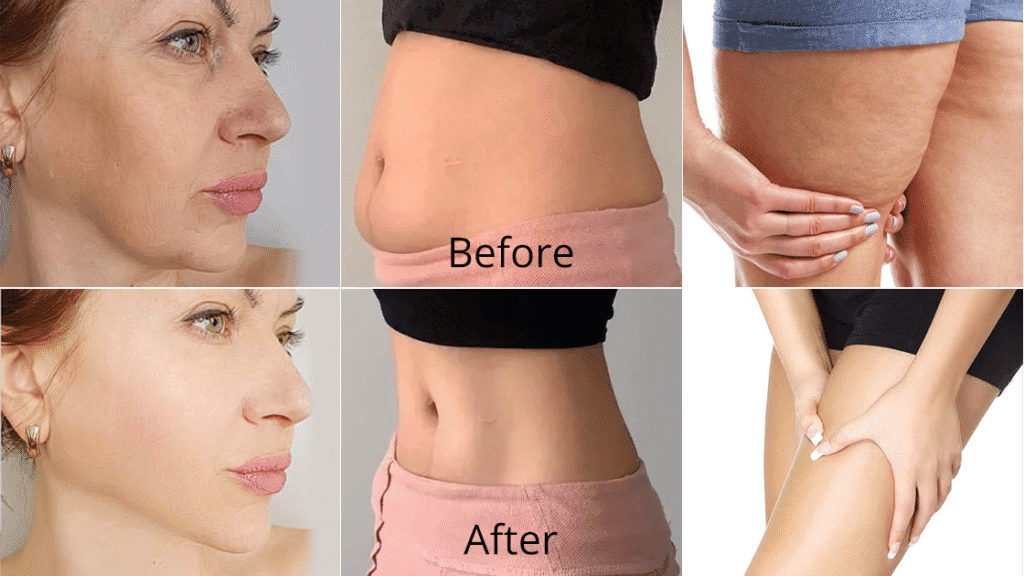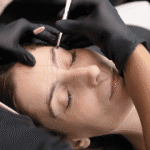1. Introduction
1.1 What is Radio Frequency (RF) Therapy?
Radiofrequency (RF) therapy is a non-invasive cosmetic treatment that uses controlled radiofrequency energy to heat the deeper layers of the skin. This process stimulates the production of collagen and elastin, which are essential proteins for skin elasticity and firmness. RF therapy is increasingly popular for its ability to tighten loose or sagging skin, improve texture, and reduce the appearance of wrinkles and fine lines. The treatment is commonly used in aesthetic practices to rejuvenate skin and enhance body contours without the need for surgery or long recovery periods. RF technology has been around for several years and is widely regarded for its safety and effectiveness in skin tightening and non-surgical body contouring.
1.2 Why RF Therapy After Childbirth?
After childbirth, many women experience changes in their body, especially in their skin. Pregnancy causes the skin to stretch and, in some cases, lose its natural firmness. This can result in loose or sagging skin, stretch marks, and an overall decline in skin texture. Radiofrequency therapy presents a safe and effective non-invasive solution to these common postpartum issues. By stimulating collagen production and improving skin elasticity, RF therapy helps new mothers regain their pre-pregnancy skin appearance and feel more confident in their bodies. Moreover, RF therapy offers a convenient and minimal-downtime solution that can easily fit into the busy lifestyle of a new mother.
2. How Radio Frequency Works After Childbirth
2.1 Understanding Radio Frequency (RF) Technology
Radiofrequency (RF) technology is a non-invasive treatment that uses electromagnetic waves to generate heat deep within the skin. When RF energy is applied to the skin, it penetrates into the dermis, which is the deeper layer beneath the surface, stimulating the production of collagen and elastin, the proteins responsible for skin firmness, strength, and elasticity. As we age or undergo significant physical changes such as pregnancy, collagen production decreases, which often leads to sagging skin and wrinkles. RF technology addresses this by triggering the skin’s natural collagen-producing cells (fibroblasts), promoting the synthesis of new collagen and elastin fibers. This is particularly beneficial after childbirth, as the skin in areas like the abdomen, thighs, and breasts may have lost its natural elasticity due to the stretching experienced during pregnancy.

2.2 Targeting Postpartum Skin Issues with RF
After childbirth, many women experience common skin concerns such as loose or sagging skin, stretch marks, and postpartum scarring. These issues can arise due to the stretching of the skin during pregnancy, which often leads to a loss of tone and elasticity. RF therapy is an excellent solution for addressing these concerns. It targets areas like the abdomen, thighs, and breasts, helping to tighten and firm the skin by stimulating collagen production. Stretch marks, which occur when the skin is stretched too rapidly, can also be improved with RF. The treatment encourages collagen regeneration, reducing the appearance of stretch marks and resulting in smoother, more even skin texture. Additionally, RF therapy can improve the appearance of scars, such as those from a cesarean section or episiotomy, by softening the scar tissue and promoting natural healing.
2.3 The Role of Collagen Stimulation in Postpartum Skin Recovery
Collagen is a crucial protein responsible for skin’s strength, elasticity, and youthful appearance. During pregnancy, the skin undergoes significant stretching, which can lead to a decrease in collagen production. This reduction contributes to sagging and loss of skin tone after childbirth. RF therapy works by stimulating the production of new collagen in the dermis, leading to firmer, more elastic skin. The process of collagen remodeling occurs as the heat from RF energy causes the skin’s existing collagen fibers to contract and encourages the production of new, stronger collagen fibers. This collagen stimulation helps tighten the skin, improve elasticity, and smooth out areas affected by pregnancy-related stretching, such as the abdomen and thighs. It also helps reduce the appearance of stretch marks and scars by promoting a more even skin texture and tone.
2.4 Benefits for the Body Postpartum
RF therapy offers significant benefits for postpartum bodies, particularly in skin rejuvenation. It tightens and firms skin, especially in areas stretched during pregnancy, like the abdomen, thighs, and breasts. As collagen production increases, women may notice a more toned, youthful appearance. RF therapy also helps reduce fat deposits, contouring the body and targeting stubborn fat in the abdomen and thighs. Additionally, it boosts circulation, delivering oxygen and nutrients to the skin’s deeper layers, improving skin tone, texture, and radiance. For women with cesarean scars, RF can also accelerate the healing process. Overall, RF therapy supports comprehensive postpartum recovery, enhancing both skin health and body contour.
3. Benefits of Radio Frequency Therapy After Childbirth
3.1 Postpartum Skin Tightening and Firmness
After childbirth, many women experience skin laxity, especially in areas like the abdomen, thighs, and breasts. The skin that was once stretched to accommodate a growing baby can lose its elasticity, leading to sagging and a lack of firmness. RF therapy is highly effective at tightening and firming the skin by stimulating collagen and elastin production. Over time, this results in smoother, more toned skin. The non-invasive nature of RF makes it an appealing option for women who are looking for a way to rejuvenate their skin without the need for surgery. By encouraging collagen remodeling and boosting skin elasticity, RF therapy can significantly improve the appearance of postpartum skin.
3.2 Reduction of Stretch Marks and Scarring
Stretch marks are a common concern for women after pregnancy. These marks form when the skin stretches too rapidly, breaking the collagen and elastin fibers. While stretch marks are natural, many women seek ways to reduce their appearance. RF therapy can be an effective solution, as it promotes collagen regeneration in the treated area. By stimulating the production of new collagen and elastin fibers, RF helps to smooth and soften the skin, which reduces the visibility of stretch marks. In addition to improving stretch marks, RF therapy can also assist in the healing of scars, particularly those resulting from a cesarean section or episiotomy. By encouraging collagen remodeling, RF therapy helps soften scar tissue, improving its texture and appearance over time.
3.3 Non-invasive and Minimal Downtime
One of the key benefits of RF therapy is that it is non-invasive and requires minimal downtime. Unlike surgical procedures, which often involve long recovery periods and potential risks, RF therapy is a safe, non-surgical option for postpartum skin rejuvenation. The treatment is generally painless, with most patients experiencing only mild warmth or a slight tingling sensation during the procedure. After the session, there is little to no downtime, allowing women to return to their normal activities almost immediately. This is particularly beneficial for new mothers who may not have the time or energy for prolonged recovery periods. RF therapy is an ideal solution for women who want to improve their skin without the need for invasive procedures or significant time away from their daily routines.
3.4 Promoting Skin Health and Radiance
In addition to tightening and firming, RF therapy promotes overall skin health by improving circulation and stimulating collagen production. The increased circulation helps deliver oxygen and nutrients to the skin’s deeper layers, which can improve skin tone, texture, and overall radiance. Many women experience a loss of skin vibrancy after childbirth due to hormonal fluctuations, stretching, and other factors. RF therapy helps to restore a youthful glow by improving skin health from the inside out. The treatment not only addresses the visible effects of pregnancy but also supports the skin’s overall vitality, leaving it looking fresh, radiant, and rejuvenated.

4. The RF Treatment Process: What to Expect
4.1 Consultation and Skin Assessment
Before undergoing any RF treatment, it’s important to schedule a consultation with a qualified practitioner. During the consultation, the practitioner will assess the condition of your skin, discuss your specific concerns, and determine the most suitable treatment plan based on your individual needs. They will also review your medical history, including any recent childbirth experiences, to ensure that RF therapy is safe for you. The consultation is a critical step in personalizing the treatment to target your unique postpartum skin issues, whether they involve tightening, stretch marks, or scarring.
4.2 What Happens During the RF Session?
During the RF session, the practitioner will use a handheld device to deliver radiofrequency energy to the targeted areas of your skin. The device emits electromagnetic waves that penetrate the skin’s deeper layers, gently heating them to promote collagen production. The treatment typically lasts between 20 and 60 minutes, depending on the size of the area being treated. Many patients report a pleasant sensation of warmth during the session, and the procedure is generally well-tolerated. There is no need for anesthesia or numbing agents, and the treatment is entirely non-invasive, making it suitable for postpartum women who want a quick, efficient solution for skin rejuvenation.
4.3 Aftercare and Post-Treatment Tips
After an RF session, most women experience little to no downtime. Some redness or mild swelling may occur, but this usually subsides within a few hours. To ensure optimal results and support the healing process, it is recommended to follow a few simple aftercare tips. First, it’s important to stay hydrated by drinking plenty of water to help flush out toxins and support the body’s natural healing processes. Second, moisturizing the treated areas with a gentle lotion can help keep the skin hydrated and supple. Finally, it’s crucial to avoid direct sun exposure for at least 48 hours after the treatment to protect the skin from sun damage. By following these aftercare guidelines, you can maximize the benefits of your RF therapy and achieve the best possible results.
5. Safety Considerations and Side Effects
5.1 Is RF Safe After Childbirth?
Radiofrequency (RF) therapy is generally considered safe for women postpartum, provided certain precautions are taken. After childbirth, your body is in the process of recovering and returning to its pre-pregnancy state. RF therapy is non-invasive, with minimal risk involved, making it a viable option for many new mothers looking to rejuvenate their skin. However, it’s important to consult with a licensed practitioner who has experience in postpartum skin care. They will assess your individual health status and make sure that RF therapy is suitable for you. Additionally, it’s advisable to wait at least six weeks after childbirth to ensure that your body has had time to heal from the physical stresses of pregnancy and delivery before undergoing any skin treatments. If you had a cesarean section, it’s best to wait until the incision has fully healed and your doctor has given you the go-ahead for such treatments.
5.2 Potential Side Effects of RF Therapy
While RF therapy is a safe and minimally invasive treatment, there are some potential side effects to be aware of. Most of these are mild and temporary, but they should still be considered before undergoing the procedure. Common side effects include mild redness, swelling, or a sensation of warmth in the treated area. These symptoms usually resolve within a few hours after treatment. In rare cases, patients may experience skin irritation, burns, or blisters if the RF energy is applied incorrectly or the skin is too sensitive. To reduce the risk of adverse effects, it’s essential to seek treatment from a qualified professional who uses FDA-approved equipment and follows proper guidelines. If any discomfort or unusual side effects persist beyond the treatment session, it’s crucial to consult with your practitioner immediately.
5.3 When to Avoid RF Therapy
RF therapy should be avoided in certain situations, including if you have active skin infections or open wounds in the area to be treated. If you have any underlying health conditions, such as heart disease, pacemakers, or conditions that affect the skin or connective tissue, it’s important to consult with a healthcare provider to determine if RF therapy is suitable for you. Additionally, women who are breastfeeding should approach RF treatment with caution and discuss it with their healthcare provider, as the safety of RF during breastfeeding hasn’t been extensively studied. Pregnant women should absolutely avoid RF treatments, as the effect of RF energy on a developing fetus is not well-understood. Lastly, women who have had recent skin surgeries, like a C-section or other abdominal surgeries, should consult their doctors to determine when it’s safe to undergo RF therapy.
6. Results and What to Expect

6.1 Timeframe for Seeing Results
Results from RF therapy are generally not immediate but develop gradually as the collagen stimulation process takes effect. After your first session, you may notice some tightening and firming in the treated area, but optimal results typically take several weeks to become visible. This is because collagen and elastin fibers need time to regenerate and remodel. Most women begin to see noticeable improvements around 3 to 4 weeks after treatment, with continued enhancement over the next few months. Typically, a series of treatments, spaced a few weeks apart, is recommended to achieve the best results. The exact number of sessions depends on individual goals, the condition of the skin, and the area being treated. Some patients may need just a few sessions, while others may require more for optimal results.
6.2 Long-term Benefits and Maintenance
The results of RF therapy are not permanent, as the body’s natural aging process continues to affect collagen production. However, the improvements achieved from RF treatment can last for several months to a year, depending on factors like lifestyle, skin care routine, and age. To maintain the results, ongoing maintenance treatments are typically recommended every 3 to 6 months. These maintenance sessions help sustain the collagen remodeling process and ensure that the skin remains firm and youthful. Alongside regular RF treatments, it’s crucial to follow a healthy skincare routine, protect your skin from sun damage, and maintain a balanced diet to further support the long-term benefits of RF therapy.
7. Who Should Consider Radio Frequency Therapy After Childbirth?
7.1 New Mothers Seeking Skin Rejuvenation
Radiofrequency therapy is an excellent option for new mothers who are looking to rejuvenate their skin after childbirth. Pregnancy often leads to physical changes, including stretch marks, sagging skin, and weakened skin elasticity. RF therapy can help improve these issues by stimulating collagen production, tightening skin, and reducing the appearance of scars and stretch marks. For women looking to regain their pre-pregnancy appearance without undergoing surgery, RF offers a non-invasive solution that fits into busy lifestyles.
7.2 Women with Stretch Marks or Postpartum Scarring
Women with stretch marks or postpartum scarring, particularly from a cesarean section, can benefit greatly from RF therapy. Stretch marks, which are often a result of the skin stretching too quickly, can be reduced in appearance with RF’s collagen-stimulating effects. The same benefits extend to scar tissue. By promoting collagen regeneration and skin healing, RF therapy helps soften the appearance of scars, making them less noticeable over time. This makes RF an ideal solution for women dealing with the aftermath of pregnancy-related skin changes.
7.3 Individuals Looking for Non-Surgical Solutions
For those who want to improve their skin’s appearance but aren’t interested in invasive surgical procedures like tummy tucks or lifts, RF therapy is a perfect option. RF provides a non-surgical solution that tightens and firms the skin without the need for cutting, scarring, or significant recovery time. This makes it particularly appealing to those who want effective results with minimal risk, discomfort, or downtime. RF therapy can be used as an alternative or complement to other skin treatments and surgeries, offering a gentle yet effective way to restore skin health and elasticity.
8. Final Thoughts
Radiofrequency therapy is a safe, effective, and non-invasive treatment option for women looking to address the skin concerns that often arise after childbirth. Whether you’re dealing with loose skin, stretch marks, or postpartum scarring, RF therapy can help restore the firmness, elasticity, and tone that pregnancy may have affected. With minimal downtime and no need for surgery, RF offers a convenient and efficient solution for those seeking skin rejuvenation. As with any treatment, it’s important to consult with a qualified practitioner to determine if RF therapy is right for you and to develop a personalized plan that suits your unique needs. The long-term benefits of RF therapy, combined with its ability to provide smoother, firmer, and more youthful skin, make it an excellent choice for women looking to reclaim their skin after childbirth.
9. FAQs (Frequently Asked Questions)
Typically, 4 to 6 sessions spaced 1 to 2 weeks apart are recommended for best results. Maintenance treatments may be required every few months.
RF therapy is generally not painful. You may feel mild warmth or a tingling sensation, which is usually comfortable and tolerable.
Yes, RF therapy can help tighten loose abdominal skin by stimulating collagen production, making the skin firmer and more toned over time.
It’s best to wait at least 6 weeks after childbirth. If you had a C-section, make sure your doctor clears you first.
RF therapy is generally safe for most skin types, but consult with a practitioner to ensure it’s appropriate for your skin condition.








